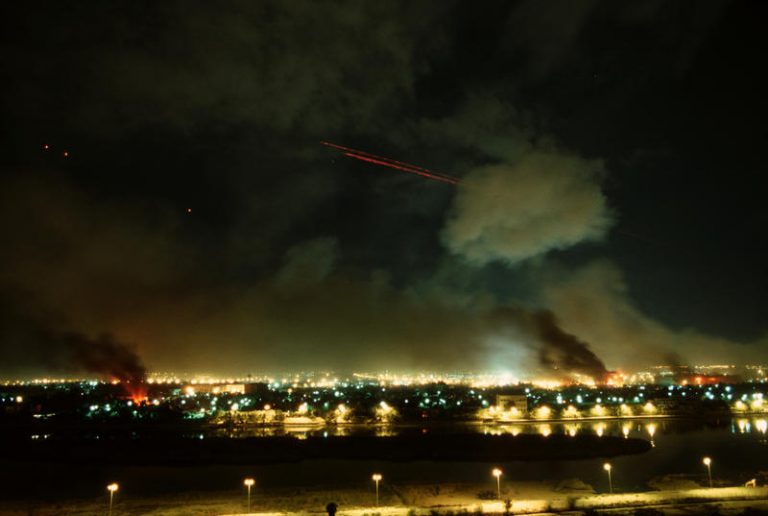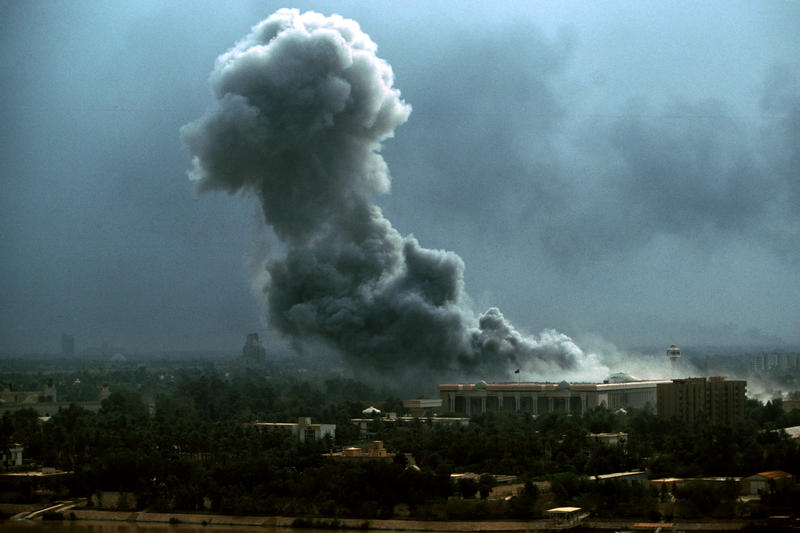
It has long been noted in writings on photography that broad swathes of historical experience so often come to be represented by a small number of iconic images: the Great Depression and Dorothea Lange’s Migrant Mother and Walker Evans’s Sharecropper Bud Fields and his Family, for example. Or the Pacific Campaign and Joe Rosenthal’s Raising the Flag on Mount Suribachi. Or the Vietnam War and Nick Ut’s Napalm Girl. It is no coincidence that two of these three examples relate to armed conflict. War seems particularly suited to icon-formation, a process that involves a complex interaction between human psychology, media ecology, aesthetics, ritual, and political communication.
The US-led coalition invasion of Iraq in March 2003 and the long-drawn-out campaigns in both Iraq and Afghanistan that followed are in this sense no exception. They, too, have produced iconic photographs. It is instructive to consider the development of these icons and to reflect, in conclusion, on the distinctive photography emerging from the current war in Ukraine.
The invasion of Iraq began with a bombardment of Baghdad, using so-called “shock and awe” tactics designed to paralyze, through a display of overwhelming force, the enemy’s will to resist. Television footage and photographs of the illuminated night sky over the Iraqi capital rapidly became iconic: easily recognized ciphers for US and western military dominance and technological superiority, enabling “surgical strikes” that were supposed to guarantee as clean a war as possible and minimize civilian casualties.
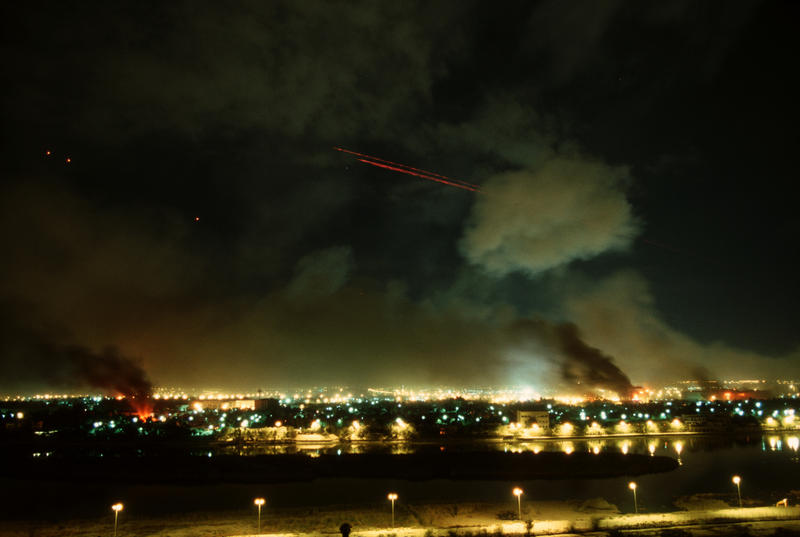
As the ground invasion progressed and coalition forces took control of the major population centres, new icons were born, in the shape of acts of iconoclasm, as US soldiers helped Iraqis topple statues of Iraq’s tyrannical ruler, Saddam Hussein.
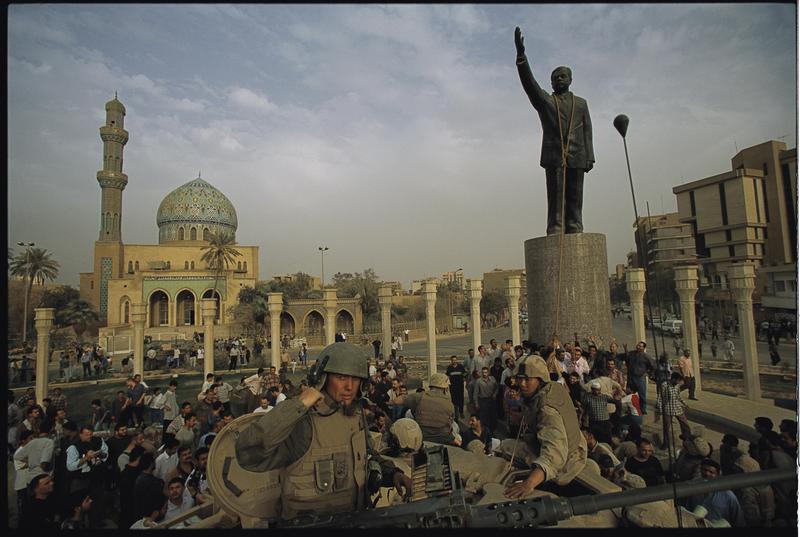
In this instance, the statue was then dismembered, and the head dragged through the streets in an act of symbolic desecration by relieved Iraqis, who felt themselves liberated from both coalition airstrikes and Saddam’s rule.
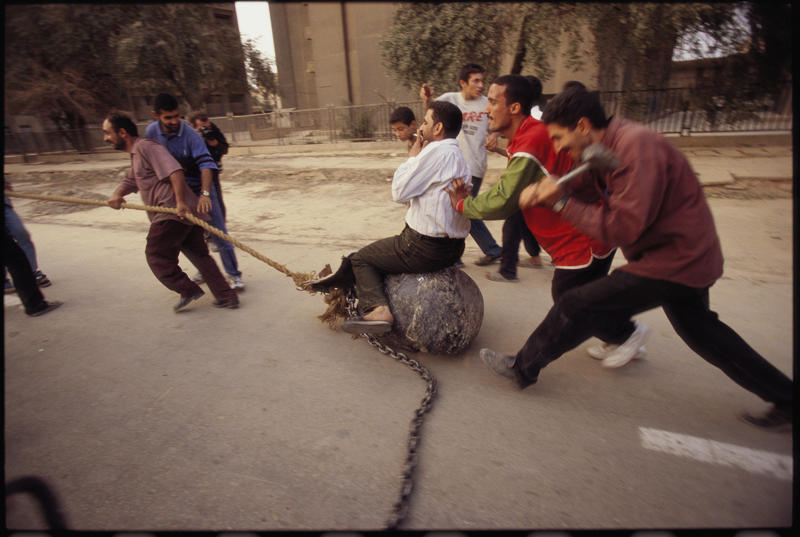
There is a clear and reciprocal relationship between these two sets of iconic images. The airstrikes – initially lambasted by many media outlets as ‘shocking and awful’ – are shown to have enabled the ground campaign, whose ostensible success, in turn, legitimized the shock and awe tactics. It is perhaps no coincidence that the initial aerial bombardments were intended as “decapitation strikes”, aimed at killing Saddam. They did not succeed (Saddam would not be caught until December 2003, nine months after the invasion started), but this is compensated for symbolically in the “decapitation” of the statue.
This is not to say that photographers did not capture other aspects of the Iraq war: photographers on the ground also meticulously documented civilian fatalities, refugees, the destruction of infrastructure, the life and death of Saddam loyalists, and Iraqi insurgents. But the images that retain iconic power in the West are those of Baghdad burning and the toppled statues of a dictator.
As the wars in Iraq, Afghanistan, and Syria dragged on and Western casualties mounted, however, another kind of photograph emerged and rapidly became iconic: the image of combat stress or trauma, as in this early example by Ashley Gilbertson, taken in 2004.
The photograph shows four off-duty US Marines. Three are sitting on sofas in an otherwise spartan room, while a fourth crouches behind. All are dressed in pale khaki combat fatigues. Their uniforms are visibly scuffed and dusty, the soldier in the center of the image is still in sand goggles, and two others are still wearing knee pads. The floor is carelessly strewn with packs and two light machine guns, all of which suggest the recent completion of a patrol or combat operation. To the left of the image, the left arm and leg of one soldier protrude into the frame. The crouching soldier in the center holds his gun in both hands, its stock pointing upwards and shoulder strap dangling. The other two marines show bodily signs of distress. On the left-hand sofa, a soldier sits with bowed head, his clenched fists raised to support the edge of his helmet. His face is invisible. More striking, however, is the figure on the right, who has been captured in the act of falling onto the sofa – note the blurred right boot – in a kneeling posture, his head buried in the cushion and his hands clasped to his helmet in a gesture of grief or despair.
Photographs of traumatized soldiers are not new, and two images from the Vietnam war have their own iconic status: Don McCullin’s Shell-shocked US Marine, taken during the battle of Hue in South Vietnam in 1968, and Larry Burrows’s photograph of a distraught Lance Corporal James C. Farley, published in his photo-essay ‘One Ride with Yankee Papa 13’ (Life, April 16, 1965) and now in the possession of the Houston Museum of Fine Arts. These photographs established an iconology of combat trauma that persists in the work of today’s prize-winning photographers. We see the blank gaze or thousand-yard stare of McCullin’s marine in, for example, Luis Sinco’s Marlboro Marine (2004), while Gilbertson’s photograph of the 1/8 Bravo Marines and Tim Hetherington’s World Press Photo of the Year, Exhausted American Soldier at Restrepo Bunker in Afghanistan (2007), replicate Farley’s gestures of placing the hands on the head and hiding the face. So conventionalized have these gestures become that they dominate stock photographs of military post-traumatic stress disorder (PTSD). But that is not my point. I am more interested in why photographs of traumatized soldiers should have become so well-known and celebrated. There are several answers to this question.
The first is also perhaps the most obvious. Since the start of the Iraq war, there have been many thousands of articles on combat stress, many of which have noted the difficulty of predicting and preventing PTSD, and indicted coalition governments for their failure to provide adequate care for the veterans affected. Ever since Charcot’s experiments with so-called hysterics at the Salpêtrière in 1880s Paris, photography has been called upon to offer vivid visual testimony of psychological disturbance. By capturing the body and the power of gesture and facial expression, photographers of combat stress and PTSD have powerfully activated this capacity of the technical image.
Linked to this is a more general critique of the war in Iraq and Afghanistan. Pervading Gilbertson’s image – and many other images of combat trauma – is a deep sense of melancholy. Indeed, the poses and physiognomy are entirely characteristic of a much longer history of the iconography of melancholy in Western art. While the invasion of Iraq had its moments of carnivalesque celebration and delight in overthrowing a tyrant – as we see in the statue images or in this photograph of a soldier sliding down the banister of an overrun palace – the dominant mode of the trauma photographs is elegiac. In this sense, they conspire with the photographs of civilian casualties to show that war involves suffering on both sides and that exposure to death – the death of others and the threat to one’s own life – takes a deep psychological toll.
This argument can, however, be turned on its head, and the photographs made to support an apologia for war rather than a critique of it. For if the aggressor can be seen to be simultaneously a victim, the invasion can be reconfigured as an act of sacrifice, and military action being undertaken as a reluctant necessity and out of a sense of global duty (with the backing of the UN) rather than an act of neo-imperialist conquest.
Linked to this is a reimagining of military heroism in an age of technologized war. As far back as the Napoleonic era and the American Civil War, the clash of mass armies created an experience of battle that was fragmented, chaotic, and divorced from any sense of strategy. We only need to read Stendhal’s La Chartreuse de Parme (1839) or Stephen Crane’s Red Badge of Courage (1895) for an insight into the disorientating psychological effects of warfare on individual soldiers. Even at this stage, traditional conceptions of individual heroism seem to be largely precluded by the anonymity of mass armies, and this became all the more so in the twentieth and twenty-first centuries, where the outcome of battles has been increasingly determined by technological and numerical superiority rather than individual agency.
First World War Germany sought to rescue the idea of the hero in terms of the troops’ ability to endure immense physical deprivation and hardship at the front in the service of the fatherland. What we see in our contemporary photographs of combat stress is a psychologization of this idea. Heroism becomes not a celebration of individual acts of valor or quantifiable acts of killing and destruction, but the ability to expose oneself to and tolerate the acute psychological stress and distress arising from urban combat.
At the same time, images of psychological trauma legitimize the deployment of remote weapons and fuel the ideology of ‘clean’ warfare, with its language of surgical and pinpoint strikes and the implicit claim that it is cost-free and bloodless. The more troops are shown to be traumatized by exposure to mortal danger or witnessing the death of civilians and their own comrades, the more pressing it becomes to eradicate, as far as possible, the necessity of ground combat and face-to-face killing. This in turn justifies the use of precision-guided missiles and Reaper drones, whose deployment is coordinated from a command center in Langley, Virginia. It turns out that operating a drone remotely has its own drastic psychological consequences, but this is not widely known. Public and congressional opposition to the use of drones has been minimal, and it may be that photographs of combat stress have inadvertently played a role in this.
Almost all the war images discussed above, particularly those of combat stress and PTSD, were enabled by the infrastructure of embedding, according to which the military allow accredited photojournalists access to front-line combat units – often at considerable personal risk. As a propaganda technique, it goes back at least as far as the First World War, even if the results have not always been as unequivocally affirmative as the military might desire. Indeed, images of soldiers suffering from combat stress or PTSD are harrowing to look at and can be powerful drivers of a critique of Western military and anti-terrorism policy. At the same time, they can operate in congruence with rather than in opposition to the legitimizing ideologies of military intervention. We need to be alert to this and to remember that the meaning of a photograph is created by its entanglement in other discourses, not inherent to the image itself. Even photographic icons, whose reductiveness would seem to stabilize historical meanings, in fact, open up space for debate, negotiation, and dissent.
The imagery emerging from the current war in Ukraine has yet to crystallize into a set of established icons. The lack of embedded journalists means that there are strikingly few photographs of front-line action, so the focus of representation has been on the infrastructural and civilian consequences of the Russian invasion: uncovering evidence of war crimes and the emotional impact of this on the distraught bereaved, crowded stations, the urban fabric ablaze following missile strikes, distant plumes of smoke beyond the horizon hinting at unseen destruction, and the burnt-out husks of Russian military hardware.
If a single photograph stands out, it is that of a tractor towing away a Russian tank, which symbolizes Russian military incompetence and the power of grass-roots action by civilians defending their homeland. If we were to identify, tentatively, the iconic photographs of the Ukraine war, we might find them in images not of soldiers, but of a politician. Volodymyr Zelenskyy, president of Ukraine, is a ubiquitous presence across the Western print and digital media, and he always looks the same: donning combat fatigues, unshaven, in the unprepossessing surroundings of his Kyiv office, exhorting the world to help Ukraine and to uphold the values of democracy against military aggression.
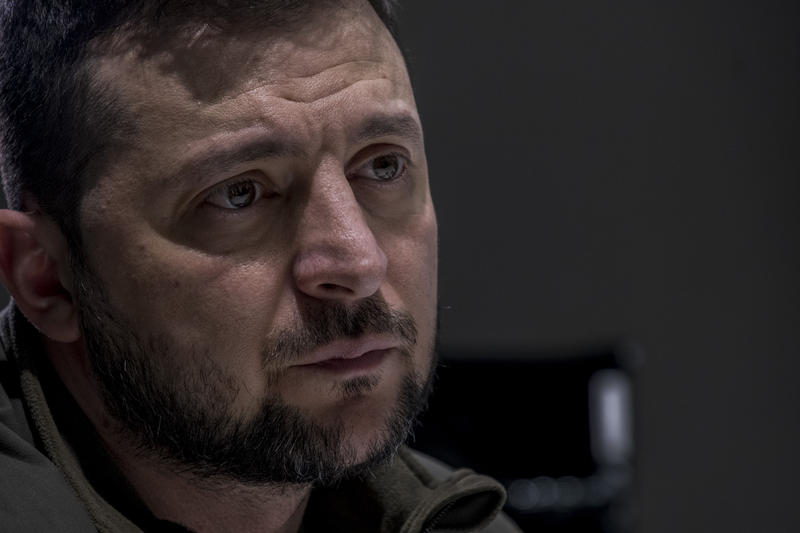
The process by which photographs become icons is complex and unpredictable, involving numerous actors and institutions. But we might tentatively suggest that whatever photographs come out of the war in Ukraine, Zelenskyy’s face will retain its iconic power. And in a conflict that is morally unambiguous in a way that Iraq and Afghanistan were not, it may prove to be an icon of unusual stability that activates not images of technological prowess or combat stress, but of genuine heroism after all.
